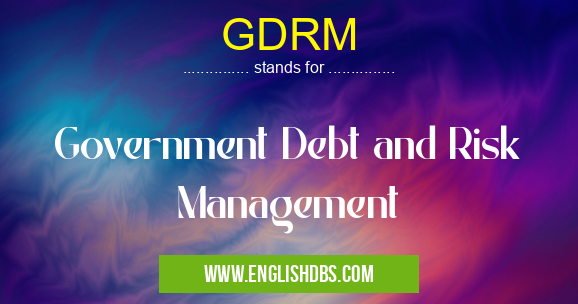What does GDRM mean in GOVERNMENTAL
Government Debt and Risk Management (GDRM) is a crucial aspect of public finance that plays a significant role in maintaining the financial stability and economic well-being of nations. It involves the management of government debt and associated risks, ensuring a balance between fiscal sustainability, economic growth, and investor confidence.

GDRM meaning in Governmental in Governmental
GDRM mostly used in an acronym Governmental in Category Governmental that means Government Debt and Risk Management
Shorthand: GDRM,
Full Form: Government Debt and Risk Management
For more information of "Government Debt and Risk Management", see the section below.
GDRM Meaning in Governmental
GDRM stands for Government Debt and Risk Management. In the context of governmental operations, it refers to the strategies, practices, and processes employed by governments to manage their debt obligations and mitigate financial risks. This involves issuing and managing government bonds, managing cash flows, and implementing policies to reduce fiscal imbalances.
GDRM Full Form
The full form of GDRM is Government Debt and Risk Management. It encompasses the following key elements:
- Government Debt: This refers to the total outstanding debt of a government, typically issued through the sale of bonds or other debt instruments.
- Risk Management: This involves identifying, assessing, and mitigating financial risks associated with government debt, such as interest rate fluctuations, currency movements, and creditworthiness.
What Does GDRM Stand For
GDRM stands for Government Debt and Risk Management. It represents the specialized field within public finance that focuses on:
- Issuing and managing government debt
- Mitigating financial risks
- Maintaining fiscal sustainability
- Ensuring investor confidence
Essential Questions and Answers on Government Debt and Risk Management in "GOVERNMENTAL»GOVERNMENTAL"
What is Government Debt and Risk Management (GDRM)?
GDRM is a specialized field within public finance that focuses on managing the government's debt and associated risks. It involves formulating strategies to raise funds through debt issuance, managing debt portfolios, and mitigating financial risks.
What are the key objectives of GDRM?
The primary objectives of GDRM are to:
- Ensure the sustainable financing of government operations
- Control the cost of borrowing
- Manage the risk profile of government debt
- Promote economic stability
How does GDRM differ from traditional debt management?
GDRM takes a more comprehensive approach to debt management by considering not only the immediate financial implications but also the potential impact on the overall economy and the government's fiscal sustainability. GDRM integrates risk management techniques to mitigate potential financial shocks and ensure the stability of government finances.
What are some of the tools and techniques used in GDRM?
GDRM practitioners utilize various tools and techniques, including:
- Debt issuance strategies
- Debt portfolio diversification
- Risk analysis and modeling
- Credit ratings management
- Fiscal risk monitoring
What are the benefits of effective GDRM?
Effective GDRM can lead to:
- Reduced borrowing costs
- Improved fiscal sustainability
- Enhanced economic stability
- Increased investor confidence
- Efficient allocation of resources
Final Words: GDRM plays a critical role in the financial management of governments. By effectively managing government debt and associated risks, governments can foster economic growth, maintain financial stability, and build trust with investors. A well-functioning GDRM system is essential for sustainable public finances and the overall economic well-being of nations.
